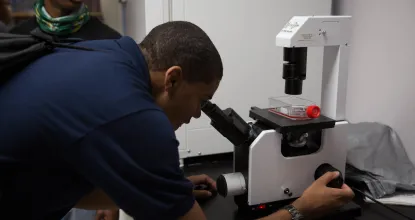Program Goals
The chief goals of the CLS major program are to provide graduates with the tools they need to successfully complete certification exams, develop them into highly competitive job applicants, foster their adaptability to carry out future job responsibilities, provide them with marketable skills early in the curriculum and present education in the most expedient manner that doesn't compromise content or comprehension.
What You'll Do as a Clinical Lab Scientist
Clinical laboratory scientists perform many routine and specialized tests in clinical, research or industrial laboratories to provide diagnostic data, supporting health care, quality control and product development. Clinical laboratory scientists may have a variety of responsibilities, including implementing and performing tests, supervising, teaching and consulting.
CLS Program Curriculum
The clinical laboratory science major incorporates didactic and clinical education throughout the four-year curriculum. Students gain marketable skills after two years in the program through clinical lab technician certification. Upon completion of the degree, students are eligible to take a national certification test for clinical laboratory scientists. The university maintains CLS affiliations with a variety of hospitals in Michigan. The sophomore and senior practicum provide an opportunity for students to experience two different clinical settings prior to graduation.
Our program concentrations include:
MLS State License Requirements
In most states, a state license is not required to work as a medical laboratory scientist and it's concentrations. In states that require a state license, the MLS concentrations meet most state requirements.
MLS concentration: Please review the state licensure chart for more information.
Microbiology concentration: Please review the state licensure chart for more information.
Anatomic Pathology, histotechnology major concentation: Please review the state licensure chart for more information.
Clinical Laboratory Science Program Outcomes
MLT Outcomes Statistics
Medical Lab Technician Outcome Statistics
7-1-2021 - 6-30-2022
| 7-1-2022 - 6-30-2023 | 7-1-2023 - 6-30-2024
| 7-1-2024 - 6-30-2025 | |
| Certification Pass Rate | 92% (12/13)
| 100% (12/12)
| 100% (7/7)
| 93% (13/14) Incomplete due to open time frame |
| Employment/Further Education Rates | 100% (7/7; 8 unknown)
| 100% (6/6; 10 unknown)
| 100% (2/2; 7 unknown)
| 100% (3/3; 13 unknown) |
| Graduation Rates | 100% (15/15)
| 100% 16/16
| 100% (9/9) | 100% (16/16) |
Last updated 10-14-2025
The clinical laboratory science program medical lab technician concentration is accredited by:
National Accrediting Agency for Clinical Laboratory Sciences
5600 N. River Road, Suite 720
Rosemont, IL 60018-5119
773.714.8880 | info@naacls.org
Program Director
Martin Renaldi, MT(ASCP), MPA
Assistant Professor/Program Director
3509 The Science Building
E-mail: mrenaldi@nmu.edu
Phone: 906-227-2808
MLS Outcomes Statistics
Medical Lab Scientist Outcome Statistics
| 7-1-2021 - 6-30-2022 | 7-1-2022 - 6-30-2023
| 7-1-2023 - 6-30-2024 | 7-1-2024 - 6-30-2025 | |
| Certification Pass Rate | 86% (12/14)
| 70% (7/10) | 100% (4/4)
| 100% (5/5) Incomplete due to open time frame. |
| Employment/Further Education Rates | 100% (18/18; 2 unknown)
| 100% (10/10; 2 unknown
| 100% (5/5; 3 unknown)
| 100% (3/3; 3 unknown) |
| Graduation Rates | 100% (13/13)
| 100% (12/12)
| 100% (8/8) | 100% (6/6) |
Last updated 10-14-2025
The clinical laboratory science program medical lab scientist concentration is accredited by:
National Accrediting Agency for Clinical Laboratory Sciences
5600 N. River Road, Suite 720
Rosemont, IL 60018-5119
773.714.8880 | info@naacls.org
Program Director
Martin Renaldi, MT(ASCP), MPA
Assistant Professor/Program Director
3509 The Science Building
E-mail: mrenaldi@nmu.edu
Phone: 906-227-2808
CG Outcomes Statistics
Cytogenetics Outcome Statistics
| 7-1-2019 - 6-30-2020 | 7-1-2020 - 6-30-2021 | 7-1-2021 - 6-30-2022 | |
| Certification Pass Rate | 0% (0/1) | N/A (0/0) | 100% (1/1) |
| Employment/Further Education Rates | 100% (1/1) | N/A (0/0) | 100% (1/1) |
| Graduation Rates | 100% (1/1) | N/A (0/0) | 100% (1/1) |
The clinical laboratory science program cytogenetics concentration is accredited by:
National Accrediting Agency for Clinical Laboratory Sciences
5600 N. River Road, Suite 720
Rosemont, IL 60018-5119
773.714.8880 | info@naacls.org
Program Director
Paul Mann, Ph.D., MLS(ASCP) MB
Professor
3713 The Science Building
E-mail: pmann@nmu.edu
Phone: 906-227-2338
DMS Outcome Statistics
Molecular Biology Outcome Statistics
| 7-1-2019 - 6-30-2020 | 7-1-2020 - 6-30-2021 | 7-1-2021 - 6-30-2022 | |
| Certification Pass Rate | N/A (0/0) | 100% (2/2) | N/A (0/0) |
| Employment/Further Education Rates | N/A (0/0) | 100% (2/2) | N/A (0/0) |
| Graduation Rates | N/A (0/0) | 100% (2/2) | N/A (0/0) |
The clinical laboratory science program molecular biology concentration is accredited by:
National Accrediting Agency for Clinical Laboratory Sciences
5600 N. River Road, Suite 720
Rosemont, IL 60018-5119
773.714.8880 | info@naacls.org
Program Director
Paul Mann, Ph.D., MLS(ASCP) MB
Professor
3713 The Science Building
E-mail: pmann@nmu.edu
Phone: 906-227-2338
Program Director
Martin Renaldi, MT(ASCP), MPA
Assistant Professor/Program Director
3509 The Science Building
E-mail: mrenaldi@nmu.edu
Phone: 906-227-2808
